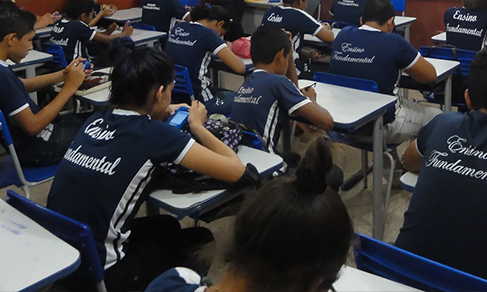Nossos serviços estão apresentando instabilidade no momento. Algumas informações podem não estar disponíveis.
PeNSE - National Survey of School Health
About - 2009
Carried out in 2009, the National Survey of School Health - PeNSE involved students of the 9th year (8th level) of the primary school in the Municipalities of the Capitals and Federal District, based on a covenant established with the Ministry of Health. The survey, conducted in accordance with norms and guidelines applied at international level in studies involving human beings, especially teenagers, had as its main objective the identification and measurement of health risk factors and protection measures in this group, using as a reference for the choice of the sample the registry of public and private schools listed in the School Census 2007, of the National Institute for Educational Studies and Research Anísio Teixeira, of the Ministry of Education – INEP.
The survey information was released in two publications. The former aims at outlining a profile of the situation of the students concerning the prevalence of factors related to chronic and non-communicable diseases, including the following subjects: Basic characteristics of the population under investigation; Maternal schooling; Social and household context; Feeding; Practice of physical activity; Cigarettes, alcohol and other drugs; Sexual and reproductive health; and Accidents, violence and security. The second publication aims at assessing the nutritional status of the group under investigation, based on the Body Mass Index - BMI, which allows the diagnosis of problems related to this issue by means of the relation between weight and height. In addition to the anthropometric measurements, the perception and attitudes of those teenagers in relation to the body weight as possible factors of risk and health protection were also taken into account.
Both publications describe the methodological procedures that guided the design of the survey, highlighting the criteria related to the delimitation of the target population, sample plan and technical and ethical aspects involved in the data collection. They also count on a glossary with the key terms and concepts to understand the results. The enclosed CD-ROM reproduces the printed volumes.
The National Survey of School Health deeply improves the knowledge about the health characteristics of the Brazilian teenager population, thus providing the executive and legislative instances, health councils and other agents related to this sector with reliable information to guide and assess health policies destined to this important population contingent.
Tables - 2009
Profile of the situation of the students
- Basic characteristics of the target population
- Mother's schooling
- Social and family context
- Food intake
- Physical education practice
- Cigarette, alcohol and other drugs
- Sexual and reproductive health
- Accidents, violence and safety
- Oral health
- Body image and attitude towards body weight
Evaluation of the nutritional status of the students
- Table 1.1 - Total estimate of students attending the 9th year of primary school, by sex and administrative dependence of school, with indication of confidence interval of 95%, according to the municipalities of the capitals and Federal District - 2009
- Table 1.2 - Estimate, total and percentage of students attending the 9th year of primary school, by sex and administrative dependence of school, with indication of confidence interval of 95%, according to the municipalities of the capitals and Federal District - 2009
- Table 2.1 - Percentage of students attending the 9th year of primary school, by nutritional status, with indication of confidence interval of 95%, according to the municipalities of the capitals and Federal District - 2009
- Table 2.2 - Percentage of male students attending the 9th year of primary school, by nutritional status, with indication of confidence interval of 95%, according to the municipalities of the capitals and Federal District - 2009
- Table 2.3 - Percentage of female students attending the 9th year of primary school, by nutritional status, with indication of confidence interval of 95%, according to the municipalities of the capitals and Federal District - 2009
- Table 2.4 - Percentage of students of public schools attending the 9th year of primary school, by nutritional status, with indication of confidence interval of 95%, according to the municipalities of the capitals and Federal District - 2009
- Table 2.5 - Percentage of students of private schools attending the 9th year of primary school, by nutritional status, with indication of confidence interval of 95%, according to the municipalities of the capitals and Federal District - 2009
- Table 2.6 - Percentage of students attending the 9th year of primary school, by sex, administrative dependence of school and nutritional status of the student, with indication of confidence interval of 95%, according to the self perception of body image - Brazil - 2009
- Table 2.7 - Percentage of students attending the 9th year of primary school, by sex, administrative dependence of school and nutritional status of the student, with indication of confidence interval of 95%, according to the attitude in relation to body weight - Brazil - 2009
Concepts and methods - 2009
As informações a seguir descrevem os metadados estatísticos, que são o conjunto de conceitos, métodos e aspectos relacionados às estatísticas, e são informações necessárias para compreender as características e a qualidade das estatísticas e interpretá-las corretamente.
Informações Gerais
Objetivo
O objetivo da pesquisa é produzir informações que permitam conhecer a magnitude dos fatores de risco e proteção à saúde, orientar e avaliar as intervenções em saúde adequadas ao adolescente, contribuindo para o monitoramento da saúde do escolar.Com a edição de 2012, espera-se ampliar o conhecimento sobre a saúde dos adolescentes, e subsidiar as políticas públicas relativas a este grupo.
Tipo de operação estatística
Pesquisa de estabelecimento de ensinoTipo de dados
Dados de pesquisa por amostragem probabilísticaPeriodicidade de divulgação
EventualPopulação-alvo
A população-alvo da pesquisa foi formada por escolares do 9º ano (antiga 8ª série) do ensino fundamental de escolas públicas e privadas, com um total de 15 estudantes ou mais nesse ano letivo.Metodologia
Em 2009, os escolares foram selecionados a partir de um plano com amostragem de conglomerados em dois estágios, onde as Unidades Primárias de Amostragem (UPAs) foram as escolas e as Unidades Secundárias de Amostragem (USAs) foram as turmas de 9º ano das escolas selecionadas. A amostra de alunos foi formada, portanto, por todos os alunos das turmas (USAs) selecionadas na amostra de escolas (UPAs).
As escolas (UPAs) foram estratificadas inicialmente levando-se em conta sua localização geográfica e dependência administrativa, de tal modo que cada estrato geográfico correspondeu a um domínio de interesse para a divulgação de resultados da pesquisa.
O cadastro de seleção da amostra foi composto pelas escolas listadas pelo Censo Escolar de 2007, do Ministério da Educação.
Dos 63411 estudantes presentes na data da pesquisa nas turmas selecionadas, 501 se negaram a participar, restando 62910 que efetivamente preencheram o questionário. Para a tabulação dos resultados apresentados, decidiu-se utilizar apenas as informações dos alunos que concordaram em participar da pesquisa e que responderam à variável sexo, totalizando 60973 alunos.
A pesquisa foi realizada utilizando o microcomputador de mão, Personal Digital Assistant (PDA), no qual foram inseridos os questionários. Um deles respondido pelos escolares e outro, por diretores ou responsáveis pela administração das unidades escolares.
Além desses foram utilizados estadiômetro (equipamento de medição de altura) e balança (equipamento de medição de peso), para coleta das medidas antropométricas.
Em 2012, mantendo a mesma metodologia, a PeNSE entrevistou 109.104 escolares em 2.842 escolas, ocorrendo cinco recusas. A PeNSE 2012 incluiu uma amostra de escolas que permite fornecer dados e indicadores mais adequados para retratar o País e que permitem uma comparabilibilidade com indicadores internacionais.
O cadastro utilizado, para a seleção da amostra pesquisada, foi formado pelas escolas de ensino fundamental listadas pelo Censo Escolar 2010, realizado pelo Instituto Nacional de Estudos e Pesquisas Educacionais Anísio Teixeira, do Ministério da Educação - INEP/MEC, que informaram possuir turmas de 9º ano do ensino fundamental nos seus turnos diurnos.
O cadastro de seleção da amostra foi constituído por 42.717 escolas que informaram possuir turmas do 9º ano do ensino fundamental, sendo 7.519 destas, distribuídas pelas capitais dos estados e Distrito Federal e o restante, 35.198, pertencentes aos demais municípios do país.
A amostra foi dimensionada de modo a estimar parâmetros populacionais (proporções ou prevalências) em diversos domínios geográficos: cada uma das 26 capitais dos estados da federação mais o Distrito Federal, o conjunto dessas capitais, cada uma das cinco grandes regiões geográficas do país (Norte, Nordeste, Sudeste, Sul e Centro-oeste), além do país como um todo.
Para a seleção de escolas nos estratos formados por municípios fora das capitais, foram agrupados os municípios seguindo critérios de homogeneidade e vizinhança, obtendo grupos de 300 a 600 turmas aproximadamente, e, em seguida, selecionada uma amostra desses grupos em cada Grande Região, de onde foram selecionadas as escolas que fariam parte da amostra.
Portanto, em 2012, a pesquisa teve planos amostrais distintos para os estratos geográficos dos Municípios das Capitais e para os cinco estratos geográficos formados pelos demais municípios. No primeiro caso, dos Municípios das Capitais, as escolas foram as unidades primárias de amostragem (UPA) e as turmas das escolas selecionadas foram as unidades secundárias de amostragem (USA). No caso dos municípios que não são capitais, as unidades primárias de amostragem foram os agrupamentos de municípios, as unidades secundárias de amostragem foram as escolas e as turmas dessas escolas foram as unidades terciárias de amostragem (UTA).
Em ambos os casos, foi selecionada, aleatoriamente e com probabilidades iguais, uma turma em cada escola selecionada que tivesse uma ou duas turmas de 9º ano do ensino fundamental, e duas turmas em cada escola com três ou mais turmas desses escolares. Em cada uma das turmas selecionadas, todos os alunos foram convidados a responder o questionário da pesquisa.
Nas duas edições, o tamanho da amostra em cada estrato foi calculado para fornecer estimativas de proporções (ou prevalências) de algumas características de interesse, em cada um dos estratos geográficos, com um erro máximo aproximado de 3% em valor absoluto ao nível de confiança de 95%.
A antropometria não foi realizada em 2012.
Técnica de coleta:
CASI - Questionário eletrônico autopreenchidoTemas
Temas e subtemas
Grupos populacionais específicos, População, Educação, Saúde, Justiça e segurançaPrincipais variáveis
As principais variáveis utilizados no levantamento são:- escolaridade materna;
- conhecimento dos pais ou responsáveis sobre o uso do tempo livre dos filhos;
- consumo de alimentos saudáveis;
- consumo de alimentos não-saudáveis;
- escovação de dentes;
- envolvimento em briga com agressão física;
- falta à aula por insegurança no trajeto casa-escola;
- falta a aula por insegurança na escola;
- tempo assistindo à TV;
- percepção quanto à imagem corporal;
- presença de pais na residência;
- prática de atividade física
- frequência de relação sexual;
- uso de drogas ilícitas;
- uso de álcool
- uso de cigarro
A PeNSE 2012 ampliou seu escopo, inserindo questões referentes ao trabalho entre escolares, saúde mental, hábitos de higiene, prevalênca de asma, uso de serviços de saúde.
- Escolaridade dos pais - escolaridade materna e escolaridade paterna
- Número de residentes por domicílio
- Trabalho entre escolares
- Posse de bens e serviços
- Verificação dos deveres de casa pelos pais
- Entendimento dos pais quanto aos problemas e preocupações dos filhos
- Hábito de tomar café da manhã
- Hábito de comer quando estão assistindo à TV
- Alimentação na escola
- Hábitos de higiene - Lavar as mãos
- Saúde mental (sentimento de solidão, perda de sono, existência de amigos)
- Uso de serviço de saúde
- Prevalència de Asma
Também em 2012, foram investigadas características do entorno e do ambiente escolar:
- Características gerais da escola (esfera administrativa, níveis de ensino, número de salas, número de alunos matriculados, valor da mensalidade)
- Estrutura de informação e comunicação
- Alimentos comercializados (cantina e ponto alternativo)
- Estrutura para atividades físicas
- Atividades e políticas (conselho escolar, atividade extraclasse, ambientes livres de tabaco)
- Aspectos de localização da escola quanto a risco de violências.
Unidades de informação
Períodos de referência
Disseminação
Nível de divulgação
Em 2009, os resultados foram divulgados para os municípios das capitais e o Distrito Federal. Em 2012, os resultados também foram divulgados para Brasil e Grandes Regiões.Instrumentos de coleta
Histórico
A segunda edição da PeNSE foi realizada em 2012, a partir de convênio celebrado entre o IBGE e o Ministério da Saúde - MS, com o apoio do Ministério da Educação - MEC.
Saiba mais
https://metadados.ibge.gov.br/consulta/estatisticos/operacoes-estatisticas/AAPublications - 2009
Pesquisa nacional de saúde do escolar : 2009 / IBGE, Coordenação de Indicadores Sociais. -
Material type: Book
Year: 2009Pesquisa nacional de saúde do escolar : 2009 : avaliação do estado nutricional dos escolares do 9. ano do ensino fundamental : municípios das capitais e Distrito Federal / IBGE, Coordenação de População e Indicadores Sociais. -
Material type: Book
Year: 2010
Description
The Brazilian Institute of Geography and Statistics - IBGE - carries out the National Survey of School Health (PeNSE), in several cities in Brazil, in partnership with the Ministry of Health and with the support of the Ministry of Education.
The research goals are:
- to get to know and measure risk and protection factors concerning teenagers' health.
- to support the monitoring of Brazilian students' health.
- to offer guidance to health initiatives aimed at this population group by providing reliable information on the subject.
Time series
#seriehistorica201792151245656
#seriehistorica201792151426267
#seriehistorica201792151529808
#seriehistorica201792151631235
#seriehistorica201791163536744
#seriehistorica201792152311516
.
Microdata
Microdata Files of PeNSE 2015 - updated on May 25, 2018
Updating
- May 25, 2018: The updating are related to:
1- Inclusion of the document "Methodological note no. 01: Information for the use of microdata - Samples 1 and 2", which includes guidelines for the use of the data of PeNSE 2015, in the "Technical information" section.
1- Inclusion of the document "Methodological note no. 02: Specification of tables and indicators - Sample 1", which includes the filters used to build the tables of the Sample 1 made available in the publication and on the PeNSE 2015 web page, in the "Technical information" section.
1- Inclusion of the document "Methodological note no. 03: Specification of tables and indicators - Sample 2", which includes the filters used to build the tables of the Sample 2, in the "Technical information" section.
4- Inclusion of the folder “PeNSE_2015_AMOSTRA1.zip” containing the microdata of Sample 1 in the “.csv”, “.sas” and “.xlsx” formats, as well as of the file “Dicionario_PENSE_Microdados_Amostra1.xls” in place of the file “Dicionario_PENSE_Microdados.xls”. The new file contains two tabs (“AMOSTRA1_ALUNO” and “AMOSTRA1_ESCOLA”) with the description of the variables associated with requirements of the questionnaires applied to the students and schools selected for Sample 1. In addition to the file previously made available:
4.1- The description "Non applicable" attributed to the code "-1" was replaced by "Jump in the questionnaire".
4.2- Amendment of the coding of the answer options attributed to variable “V008 – Administrative sphere of the school” (previously coded as “1 – Municipal; 2 – State; 3 – Federal; 4 – Private”): in the document now made available, the coding is “1 – Federal; 2 – State; 3 – Municipal; 4 – Private”.
5- Inclusion of the folder “PeNSE_2015_AMOSTRA2.zip” containing the microdata of Sample 2 in the “.csv”, “.sas” e “.xlsx” formats, as well as of the file “Dicionario_PENSE_Microdados_Amostra2.xls”, which contains two tabs (“AMOSTRA2_ALUNO” and “AMOSTRA2_ESCOLA”) with the description of the variables associated with questionnaire items applied to the students and schools selected for Sample 2. - May 5, 2017: The updating are related to:
1- Exclusion of the variable EXTRATO_EXP_CHAR from the files "PENSE_AMOSTRA2.csv", "pense_amostra2.sas7bat", and "PENSE_2015_Microdados.v3.xlsx", as it is the same variable as EXTRATO_EXP.
2- Inclusion of the variable school, which corresponds to the primary sampling unit - UPA in the files "PENSE_AMOSTRA2.csv", "pense_amostra2.sas7bat" and "PENSE_2015_Microdados.v3.xlsx".
3- Amendment of the variable school in the AMOSTRA1_ALUNO and AMOSTRA1_ESCOLA tabs of the file "Dicionário_PENSE_Microdados.xls", whose description became an UPA.
4- Inclusion of the variable school in the AMOSTRA2 tab of the file "Dicionário_PENSE_Microdados.xls", whose description is an UPA.
- September 2, 2016: Stratum variables were added, used in the expansion.
- September 2, 2016: The micro data became also available in XLSX format.
Downloads
Technical Information
Methodological considerations on the National Survey of School Health - PeNSE can be obtained in the Technical notes chapter of its results publication.
Additional methodological notes on the 2015 edition
- Methodological note 01 - Informatio for the use of microdata - Samples 1 and 2
- Methodological note 02 - Specifications of tables and indicators - Sample 1
- Methodological note 03 - Specifications of tables and indicators - Sample 2
News and Releases
IBGE survey shows a decade of information on students’ health
A decade of surveys about teenage health and its tendencies. That is what the IBGE has released today...
13/07/2022
2019 PeNSE: one out of every five female students has suffered sexual violence
Nearly 14.6% of students aged 13 and 17, has, at some point in their lives and against their will, been...
10/09/2021
One of every five school girls has suffered sexual violence
Sexual violence is present in the lives of a significant percentage of boys and girls who attend school....
10/09/2021
Six of every ten students had tried alcoholic drinks in the pre-pandemic period
Nearly 63.3% of students from public and private schools aged 13 to 17 have already tried alcoholic drinks...
10/09/2021
A matter of gender: mental health indicators are worse for girls
Girls, most of the time, have been feeling sadder than boys. And also more worried or feeling that nobody...
10/09/2021
Study defines Brazilian students' health conditions and habits
Non-communicable chronic degenerative diseases, which are responsible for 72% of deaths in the world,...
08/04/2019
Errata
Correction of the codification of answers to variable “V008 – Administrative sphere of the school” in the data dictionary of PeNSE 2015
Published date: 25/05/2018
Description:
The error resulted from a failure in the typing of possible answers to variable “V008 – Administrative sphere of the school” in the data dictionary of PeNSE 2015. The inversion of categories “1 – Municipal” and “3 – Federal” generated incorrect results for "Administrative sphere of the school". The variable, previously codified as “1 – Municipal; 2 – State; 3 – Federal; 4 – Private”, was changed into: “1 – Federal; 2 – State; 3 – Municipal; 4 – Private”.
Actions: Correction of the codification of the possible answers to to variable “V008 – Administrative sphere of the school” in the data dictionary of Pense 2015.









